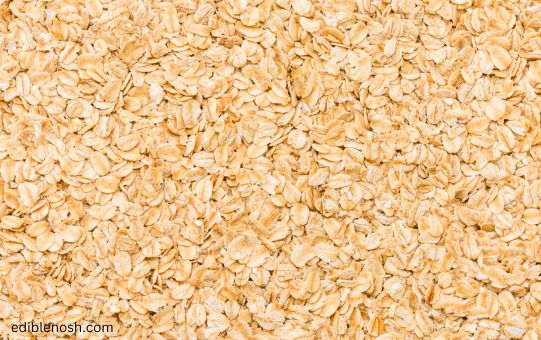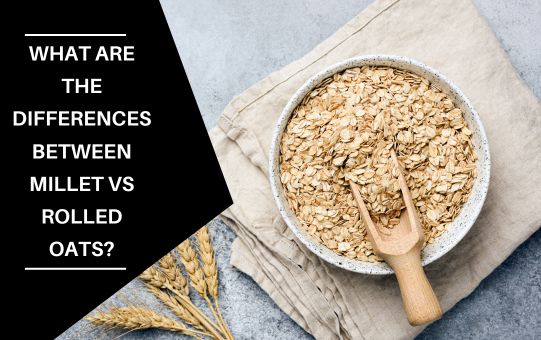Most peoples want to ask about the differences between millet vs rolled oats because these two popular grains that have gotten a lot of attention for how healthy they are and how useful they are in the kitchen.
What are the differences between millet vs rolled oats? Millet vs rolled oats is ancient grains that have been consumed for centuries in different parts of the world. These grains are known for their rich nutrient profiles and are often included in healthy diets.
Understanding the differences between millet vs rolled oats can help you make informed choices about your dietary preferences and nutritional needs.
Both millet and rolled oats have health benefits, but they are different in taste, texture, nutritional value, and how they can be used in cooking. So let’s dive into the article to get the information to keep you stay healthy.
Contents
Definition of Millet and Rolled Oats
Millet refers to a group of small-seeded grasses that are commonly cultivated and consumed as staple foods in many countries. There are several types of millet, including pearl millet, foxtail millet, finger millet, and proso millet. Each variety has its own unique properties and culinary uses.
On the other hand, rolled oats, also known as old-fashioned oats, are whole oats that have been steamed and then flattened with large rollers. This process makes them quicker to cook and more easily digestible than other forms of oats, such as steel-cut oats.
What are the differences between millet vs rolled oats?
Millet and rolled oats differ in terms of their composition, taste, and culinary uses. Millet is a group of small-seeded grasses that are rich in complex carbohydrates and higher in protein compared to rolled oats. It has a mild, slightly nutty flavor and a light, fluffy texture when cooked.
On the other hand, rolled oats are whole oats that have been steamed and flattened, making them quicker to cook. They are slightly higher in carbohydrates and lower in protein compared to millet. Rolled oats have a milder taste and a soft, creamy texture when cooked.
Both millet and rolled oats offer various health benefits, such as heart health, digestive health, and blood sugar regulation. They can be used in a variety of dishes and are suitable for gluten-free diets. The choice between millet and rolled oats depends on personal preferences, dietary needs, and culinary versatility.

Nutritional Comparison
Macronutrient Composition:
In terms of macronutrient composition, millet and rolled oats have some differences. Millet is a good source of complex carbohydrates, providing sustained energy.
It is also relatively high in protein compared to most other grains. Rolled oats, on the other hand, are slightly higher in carbohydrates and lower in protein compared to millet. However, rolled oats contain a higher amount of dietary fiber.
Fiber Content:
Both millet and rolled oats are excellent sources of dietary fiber, which plays a crucial role in maintaining digestive health, regulating blood sugar levels, and promoting satiety.
However, rolled oats contain more soluble fiber, which is beneficial for heart health, while millet contains more insoluble fiber, which aids in preventing constipation.
Micronutrients:
Millet and rolled oats are both rich in essential micronutrients. Millet contains significant amounts of magnesium, phosphorus, and copper, which are important for bone health and energy production.
Rolled oats, on the other hand, are particularly high in manganese, selenium, and thiamine, which are essential for various bodily functions, including metabolism and cell protection.
Health Benefits
Both millet and rolled oats offer numerous health benefits due to their nutrient profiles.
Heart Health:
The soluble fiber in rolled oats helps reduce cholesterol levels, lowering the risk of heart disease. Millet contains magnesium, which helps relax blood vessels and supports cardiovascular health.
Digestive Health:
The fiber content in both millet and rolled oats aids in maintaining a healthy digestive system by promoting regular bowel movements and preventing constipation.

Blood Sugar Regulation:
The complex carbohydrates and fiber in millet and rolled oats contribute to stable blood sugar levels, making them suitable for individuals with diabetes or those looking to manage their blood sugar.
Weight Management:
The high fiber content in both millet and rolled oats promotes a feeling of fullness and helps control appetite, supporting weight management efforts.
Read Also>>> What are the differences in millet vs millet flour?
Culinary Uses and Versatility
Millet and rolled oats have different culinary uses and can be incorporated into a variety of dishes.
Millet can be cooked as a side dish, similar to rice or quinoa, and used as a base for salads, soups, or porridge. It can also be ground into flour and used for baking bread, muffins, or pancakes.
Rolled oats are most commonly used for making oatmeal, granola, or baked goods like cookies and muffins. They can also be blended into smoothies or used as a topping for yogurt and desserts.
Allergies and Sensitivities
Millet and rolled oats are generally well-tolerated by most people and are not commonly associated with allergies or sensitivities.
However, as with any food, individuals with known allergies or sensitivities should exercise caution and consult with a healthcare professional if necessary.
Gluten-Free Option
Both millet and rolled oats are gluten-free, making them suitable alternatives for individuals with celiac disease or gluten sensitivity. However, it’s important to ensure that the oats are labeled as gluten-free, as they can be contaminated with gluten during processing.
Environmental Impact and Sustainability
From an environmental standpoint, millet has a lower water footprint and requires fewer resources compared to oats. It is a drought-resistant crop and can be grown in arid regions, making it a more sustainable option in certain areas.
Cost Comparison
In terms of cost, millet is often more affordable than rolled oats, making it a budget-friendly choice for those seeking nutritious grains.
Cooking and Preparation Methods
Millet and rolled oats require different cooking and preparation methods.
To cook millet, it is usually rinsed and then simmered in water or broth until tender. The cooking time varies depending on the type of millet.
Rolled oats can be cooked on the stovetop with water or milk, or prepared in the microwave. They require a shorter cooking time compared to other types of oats.
Availability and Accessibility
Both millet and rolled oats are widely available in most grocery stores, health food stores, and online retailers. They are accessible to individuals looking to incorporate them into their diet.
Taste and Texture
Millet has a mild, slightly nutty flavor and a light, fluffy texture when cooked. Rolled oats have a milder taste and a soft, creamy texture when cooked. The texture of oats can vary depending on the cooking method and the desired consistency.
Recipe Ideas
Millet:
- Millet Salad with Roasted Vegetables and Feta Cheese
- Millet Porridge with Berries and Almonds
- Millet-Stuffed Bell Peppers
Rolled Oats:
- Classic Overnight Oats with Fresh Fruit and Nuts
- Baked Oatmeal Cups with Apples and Cinnamon
- Oatmeal Raisin Cookies with a Twist
Which One Should You Choose?
The choice between millet and rolled oats depends on personal preferences, dietary needs, and culinary requirements.
Both grains offer valuable nutritional benefits and can be incorporated into a balanced diet. It is recommended to experiment with different recipes and preparations to find what suits your taste and health goals.
Read Also>>>Which one is considered better millet vs lentils?
Conclusion
Millet and rolled oats are both nutritious grains with unique characteristics. While millet is higher in protein and contains more insoluble fiber, rolled oats excel in soluble fiber content.
Both grains offer health benefits, such as promoting heart health, aiding digestion, regulating blood sugar levels, and supporting weight management. They can be used in various culinary applications and are suitable for gluten-free diets.
FAQs
Following are the FAQs about millet vs rolled oats:
What are rolled oats benefits?
Rolled oats provide fiber, promote heart health, aid digestion, control blood sugar, aid weight management, and offer antioxidant properties, making them a nutritious and versatile food choice.
Can millet and rolled oats help with weight loss?
Yes, the high fiber content in both millet and rolled oats can promote satiety and support weight management efforts.
Are millet and rolled oats good sources of protein?
Millet is relatively higher in protein compared to most grains, while rolled oats contain moderate levels of protein.
How do millet and rolled oats affect blood sugar levels?
The complex carbohydrates and fiber in millet and rolled oats contribute to stable blood sugar levels, making them suitable for blood sugar regulation.
is oats a millet?
Oats are not a millet; they are distinct cereal grains from different plant species.
Which is good millet vs oatmeal?
Millet is gluten-free, with a nutty flavor, while oatmeal is heart-healthy and has a creamy texture. The choice depends on preferences and dietary needs.

